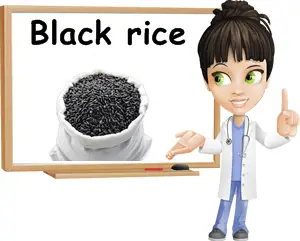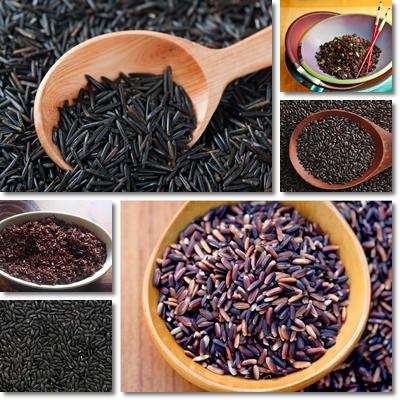Purple or black rice (Oryza sativa linnaeus) is considered to be the healthiest rice variety, with a higher vitamin and mineral content than both white and brown rice. Black rice owes its color to powerful natural pigments called anthocyanins which boast an impressive antioxidant activity, adding to the health benefits of the variety. Anthocyanin antioxidants are known to protect cells against damage caused by harmful reactive oxygen molecules called free radicals.
In addition to being a good source of vitamin E, fiber and protein, black rice is shown to help reduce inflammation levels in the body, contribute to digestive health and relieve constipation, among other benefits. According to research, regular consumption contributes to the prevention and management of serious conditions such as atherosclerosis, hypertension, high cholesterol levels, arthritis, allergies and even cancer.

Black rice vs white rice and brown rice
How is black rice different from white and brown rice? First of all, some black rice varieties are stickier than regular white rice or brown rice due to a lower amylose content and a higher amylopectin content. Amylose and amylopectin are the two components of starch. Stickier black rice is thus called glutinous; despite being called so, it contains no gluten. Secondly, its dark color is the result of a high anthocyanin content which gives rice a black pigment when raw. After cooking, black rice turns a deep purple color, which is why it is also called purple rice.
What does black rice taste like?
Actually, black rice has a mildly nutty taste and can even be described as faintly sweet. Paired with a sticky texture, it is ideal for desserts such as rice pudding, rice bread, even noodles, pasta and so on. Overall, black rice is ranked healthier than brown rice and regular consumption is said to contribute to overall health.
Also see benefits of brown rice.

What are the benefits?
See below what are the top 5 reasons why you should consider including black rice in your diet:
High antioxidant content
The dark color of black rice indicates the presence of powerful antioxidant-pigments called anthocyanins. The same anthocyanins that give black rice its black and purple coloring can be found in blackberries and blueberries. As you may already know, blueberries, blackberries and other dark-colored fruits boast an incredible antioxidant activity. And so does black rice. Antioxidants are thought to prevent cell damage caused by free radicals and thus provide protection against chronic illnesses such as diabetes, heart disease and even reduce cancer risks by treating conditions that may evolve into cancer.
Black rice protects heart health
The high anthocyanin content in black rice prevents plaque buildup on artery walls, the main cause for atherosclerosis and heart attacks. The plaque that shrinks arteries is actually fat, calcium and other deposits. Apparently, the anthocyanins in dark-colored fruits and vegetables and black rice control cholesterol (blood fat) levels and thus contribute to maintaining a healthy heart and a healthy circulatory system. They are believed to be as effective as some of the most efficient medicines used for treating high cholesterol.
Delays aging signs
One of the main functions of antioxidants is to prevent cell damage and help repair damaged cells. This basically means that with enough antioxidants, our body might keep on in good health indefinitely due to having perfectly healthy working cells. In theory, cell health is the basis for good health, with everything it implies, from lower risks of chronic disease to slower aging and better quality of life even in old age. There is actual scientific evidence that a diet consisting of antioxidant-rich foods such as blueberries or blackberries slows down cellular aging, delaying aging signs and protects against chronic disease.
Disease prevention
Black rice is said to help prevent diabetes, Alzheimer’s disease and even cancer due to its high antioxidant content. The variety also helps regulate blood sugar levels, further contributing to lower type 2 diabetes risks and improved energy levels. As far as Alzheimer’s and cancer are concerned, it has been theorized that antioxidants in black rice prevent massive cell damage that could be responsible for the onset of such diseases.
Has no gluten
Being gluten-free, black rice can be safely eaten if you are suffering from Celiac disease, gluten intolerance or even wheat allergy. Black, red, purple and brown rice, refined white rice, amaranth, buckwheat and quinoa are all gluten-free and thus easy on the digestive system, allowing for digestion to run its normal course without side effects.
Also see benefits of red rice.
Now let’s compare some of the nutrition facts for various rice varieties:
- Refined white rice: 6.8% protein, 1.2% iron, 0.5% zinc, 0.6% fiber.
- Brown rice: 7.9% protein, 2.2% iron, 0.5% zinc, 2.8% fiber.
- Red rice: 7.0% protein, 5.5% iron, 3.3% zinc, 2.0% fiber.
- Black rice: 8.5% protein, 3.5% iron, 1% zinc, 4.9% fiber.
Conclusion
Overall, black rice is by far the healthiest rice variety. It supports cardiovascular health, delays aging and plays a part in the prevention of certain illnesses such as diabetes and Alzheimer’s. Regular consumption appears to improve blood cholesterol levels and reduce inflammation. Low in sugar and rich in fiber, black rice makes a genuinely healthy dietary choice. If you go for whole black rice, then you will also get good amounts of vitamin E, an excellent natural skin care agent and antioxidant.
